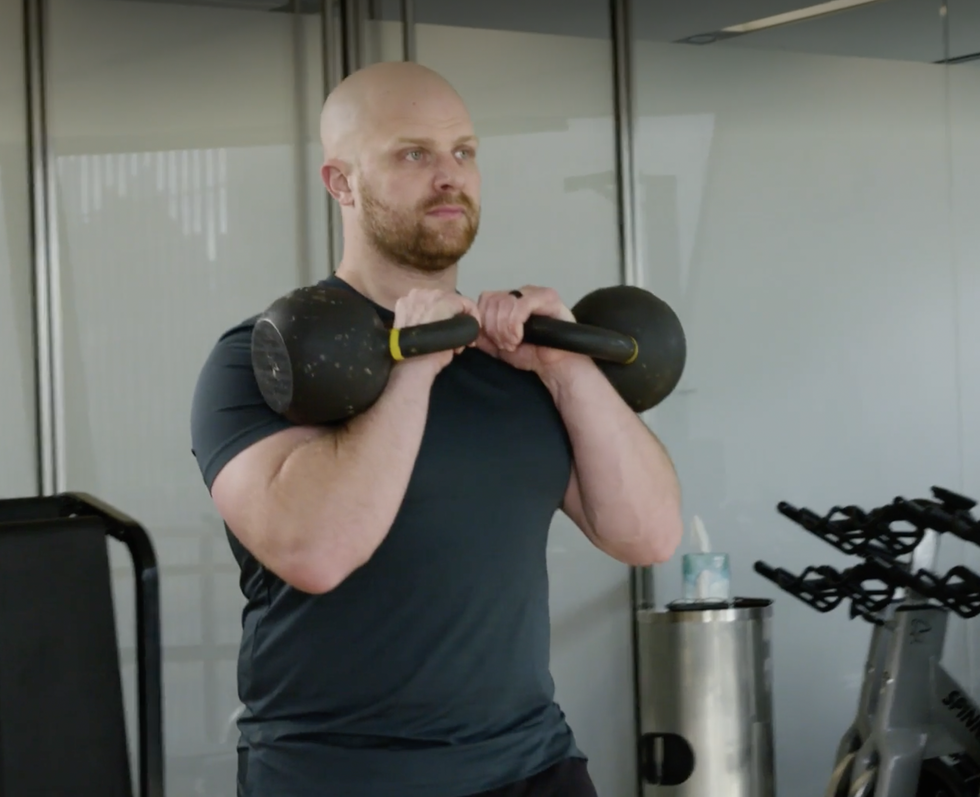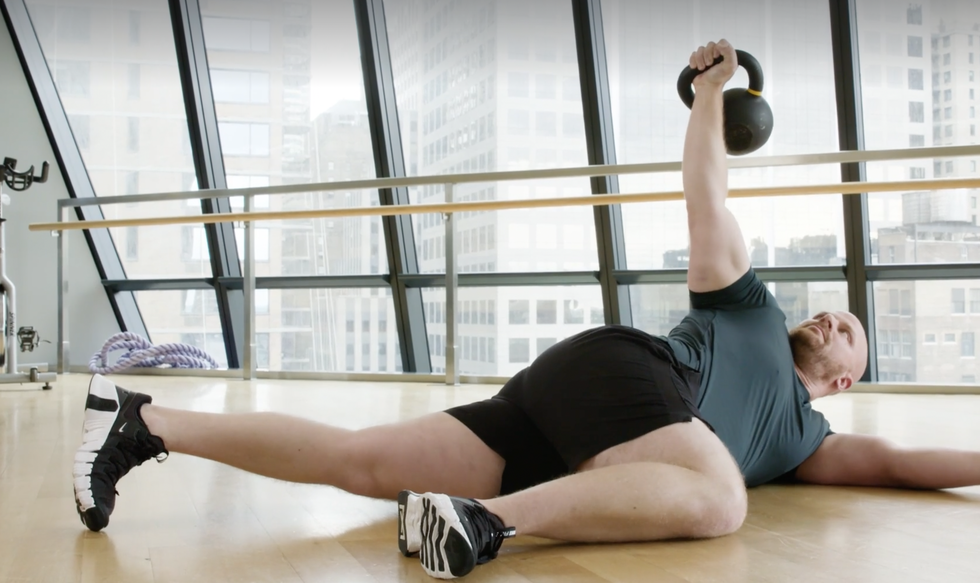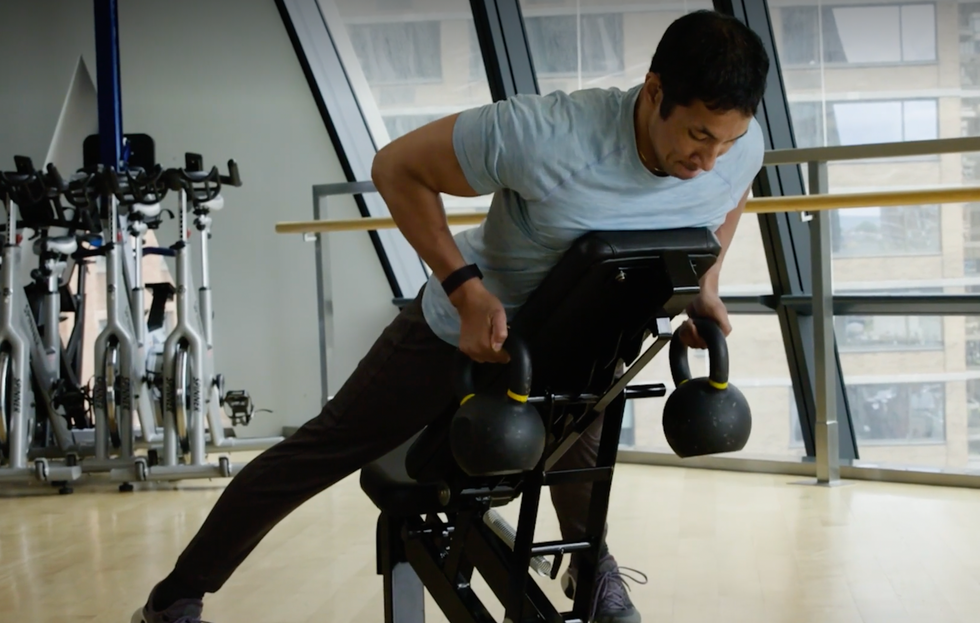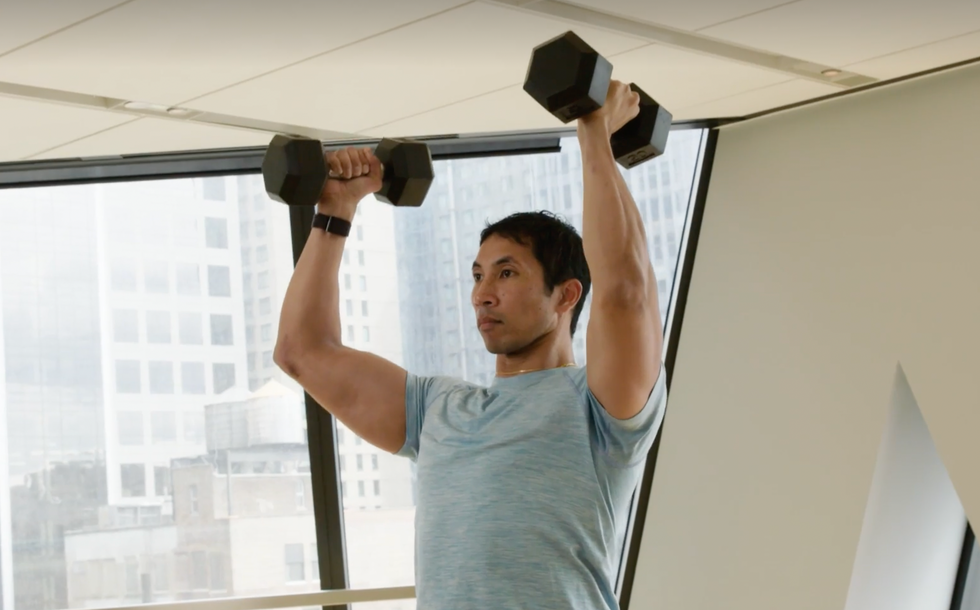THINK ABOUT HOW you train your shoulders at the gym. You probably have a round-up of the classics: dumbbell military presses, lateral raises, and maybe even barbell overhead presses and behind the neck presses.
Yes, overhead lifts have a place in your routine, but you might run into some joint issues over time if you’re only working on pushing heavy weight with these few exercises. Importantly, the health of your shoulder joint doesn’t always directly correlate with your strength. There’s a difference between exercising for shoulder strength and shoulder health.
The shoulder is a complicated mechanism—and it’s not just the top of your arm. Your shoulders run from the midline of the body all the way across the arm. Moving the arm means activation of the shoulder in some regard. Many of the moves we see in the gym require some kind of shoulder recruitment, such as a bench press or bent-over row.
“The only way to get stronger is to have healthy shoulders,” says MH Advisory Board member David Otey, C.S.C.S. “Moving the arm with proper [shoulder] rhythm is imperative to ensure that I’m going to get the strength out of my muscles but I’m maintaining the health of the joint at the root of the entire thing.”
To build shoulder strength, you need to train proper movement to keep the joint healthy before loading it up with resistance. Here, Otey and Men’s Health fitness director Ebenezer Samuel, C.S.C.S. demonstrate five exercises that you can add to your shoulder day to improve your shoulder health—which will lead you to even better gains.
5 Must-Do Exercises for Better Shoulder Health
Front Rack Carry
3 sets of 30 to 40 second walks
Proper shoulder health requires control over the shoulder blade. Carries involve a fluid walking motion, so it’s easy to forgot about what you’re doing. It’s important to keep your attention focused on the squeeze of your shoulder blades through the entire movement as you support the weight in the front rack position.
Ideally, this exercise is done with kettlebells, but you can also use dumbbells if that’s what you have available to you. Once you have the weights racked, make sure that your forearms are perpendicular to the ground and your shoulder blades are retracted to prevent your back from being pulled forward by the load. Keep your core squeezed nice and tight. This move “teaches a lot of good overall torso positioning that’s going to feed shoulder health in the long term,” says Samuel.
Arm Bar
3 to 4 sets of 6 to 8 reps
Stability is vital for healthy shoulders. This exercise will help you to hone that.
“The arm bar is a static weight and now your body is moving around that, which makes it a great drill for the shoulder,” says Otey. This exercise helps you “dynamically stabilize that joint, but let it freely move how you feel comfortable.”
The goal here is not about how heavy of a kettlebell you can hold. Focus on keeping the arm as still as possible while your body moves around it in order to train that stability. This movement can also be used as a warm up exercise to prepare your body for shoulder or upper body day.
Chest-Supported Row
3 to 4 sets of 8 to 12 reps
Maintaining healthy shoulders also means maintaining a healthy back. We need our back muscles to be able to pull our shoulders back. A chest-supported row will help strengthen the mid-back and rear deltoids. Having the chest supported through this movement forces you to take momentum out of the equation, narrowing in on those back muscles. You’ll also be able to load up the weight since there’s less need for stability through the entire spine, so don’t be afraid to go heavy on this movement.
Overhead Press with Eccentric Focus
3 sets of 6 to 8 reps
The overhead press is a staple shoulder exercise, but it can be difficult to understand the path the elbows should take on the lowering portion of the movement. Many think the proper position means having your shoulders right in line with your body. According to our experts, the most optimal position for you to be in on overhead press lifts is the position that feels the most natural for you—but that can be hard to identify. Slowing down that lowering portion of the exercise will allow you to take time to understand “where your elbow should be in position to your body when you’re going through proper pushing,” Otey says.
Lower down for three to four seconds to get the most out of this exercise. Make sure your abs and glutes are activated to ensure proper alignment through the spine. You’ll feel that countdown pretty quickly, so don’t overload the weight with this.
Face Pull
3 to 4 sets of 10 to 15 reps
Two movements that everyone needs to train for better shoulder health include external rotation (turning the hand away from the body) and scapular retraction (pulling the shoulder blades together). The one move that’s going to incorporate both of these things is the face pull.
Program this movement in as a warm up to your upper body day to wake up the shoulders and the mid-back. When you pull back, “think about making [your] hands into goalposts” at the top of the movement, Samuel says. Keep the weight light—this is more about activation then building muscle.
Cori Ritchey, NASM-CPT is an Associate Health & Fitness Editor at Men’s Health and a certified personal trainer and group fitness instructor. You can find more of her work in HealthCentral, Livestrong, Self, and others.
Brett Williams, a fitness editor at Men’s Health, is a NASM-CPT certified trainer and former pro football player and tech reporter who splits his workout time between strength and conditioning training, martial arts, and running. You can find his work elsewhere at Mashable, Thrillist, and other outlets.







Comments are closed.